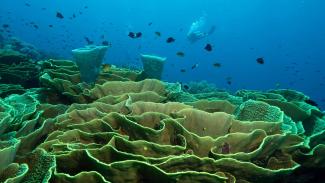
Tara North
If you are reading this article, then you probably have the bug. No doubt you’ve seen some incredible underwater photos in dive magazines or had a go and are eager for more.
There’s no doubt that having your own camera & housing is essential for your new hobby. There is such a wide range of options available today though, so how do you begin to choose?
Here, we will try and help you focus on the key aspects, so that you can make an informed decision on your camera & housing and start to enjoy your new hobby straight away.
Which camera?
What's the Point?
First, you need to think about what you want to use the camera for - and this in turn helps to determine your budget. If you simply want to take a few snapshots from your dive holiday & are not so interested in learning the finer points of underwater photography, then a point & shoot model, such as a Sony Cybershot or Canon Ixus should suffice.
If you are interested in learning a little about underwater photography & having a few controls at your disposal to improve your image making skills, but feel that an SLR is a step too far, then there are a few great consumer digital cameras on the market that offer full manual controls, such as the Olympus SP350 or Canon A540. These models are still relatively inexpensive, but allow you to develop your skills and adjust vital settings like shutter speed or aperture as your confidence grows.
Finally, if you really want to splash out and are interested in taking very high quality images for entry into competitions or for publication, then you need to look at Digital SLR models.
The Pixel Conundrum
Another area to consider is the number of megapixels. A normal photo of a decent quality, for use as a screensaver or a slideshow for example, is fine at around 6 megapixels, or even less. This means that 6 million pixels, or little dots come together to make the image. If you want to create larger images, such as posters, or take photos that can be entered into competitions or submitted to magazines, then you should probably be looking at a model with a minimum of 8 megapixels. The very top cameras now have in excess of 20 megapixels, but this is not neccesary for your average photographer.
As an underwater photographer, you should also be a little wary of tiny cameras with a large number of megapixels. While these may be great cameras on land, they have a tendency to get hotter than larget cameras as the elctronics are crammed together, increasing the chances of fogging underwater.
Function over Form
In addition to the size of the images, the functions available to you on a specific model are very important for underwater photography. The ability to manually set the white balance is extremely useful. Setting the white balance, quite simply, means telling the camera what colour is white in different lighting conditions. Once the camera knows this, then it can adjust its balance so that all your colours look great.
Macro photography is also very popular among divers as small critters make fascinating subjects. If you think you would like to have a go at some macro subjects, it’s very useful to have a camera that has a small minimum focus distance & will allow you to focus manually. A good minimum focus distance for underwater is around 2 - 5cm.

Wuestenigel

Wuestenigel
Starting on the right foot...
So by this simple thought process, you can narrow down a smaller range of cameras that are suitable for you and also what housing might be better. You will almost certainly be left with a few options though. How do you narrow this down to just one camera & housing? And how do you know you are making the right decision?
Ask the Experts
Firstly, if you are purchasing the equipment from a reputable dealer, they should give you honest advice on the strengths and weaknesses of individual models. Ask around a few different shops and concentrate on the quality of advice, rather than just the price. Secondly, internet forums are a great place to receive advice or learn of other people’s experiences with a particular camera or housing.
There are a range of useful websites with a wealth of information and forum topics, both for cameras and specifically for underwater photography. Things to consider are if the camera has been on the market long enough to have a good track record; if they are considered reliable; if you can access all the controls you need underwater; if they are considered to shoot good colours; & if they have any glitches or small design faults.
Give it a Go
Another good option is to take a short course in underwater photography, or make a few try dives with an instructor and a good camera before making your final decision. Once you have a little experience for yourself, then you are in a much better position to make an informed decision on the features of a camera & housing set-up that are most important to you.
By following this process and finding the answers to these questions, you will be able to get an excellent idea of which camera & housing is right for you - ensuring that you avoid any expensive mistakes & enjoy your new hobby from the word go!

Tara North
You might also enjoy...
Kimbe Bay
Kimbe Bay is on the island of New Britain, a large island running east to west that separates the Solomon Sea to the south from the Bismark Sea to the north.
The area is known for its stunning coral formations and boasts a huge diversity of marine life, from Dolphins, Sharks and Whales to endless tiny invertebrates.
Choosing the right dive center
Behang
If you are learning to dive or taking a diving course, it is important to have the right people around you and to learn in the right environment. Likewise, if you are already a diver who is planning a diving break, you want to make sure your dives are remembered for all the right reasons.
Underwater photography etiquette
Tara North
Underwater photography can be a absorbing hobby. Every avid underwater photographer has had moments so lost in his own world that they momentarily forget about everything else around them.
But we photographers have a responsibility to behave ourselves underwater and set a good example.
Find out how with our guide to photo etiquette...
Maumere
Maumere is a beautiful bay on the north coast of Flores. It is an area that is famous for its diversity.
Sperm Whales, Pilot Whales, Dolphins & Whalesharks cruise the bay, good encounters with Sharks & large Rays are possible and there is a wealth of macro life to keep any diver fascinated for hours.
Dummie's guide to camera kit
Jakob Owens
Do you struggle to know your arm from your socket, your port from your bracket, your flash from your fisheye and your light from your lens?
Well, you're not alone. Underwater photography has it's own dictionary of parts, accessories & technical terms and it's tough to sound like an expert.
Scuba Diving Terms - A Dummies Guide
Frans Daniels







